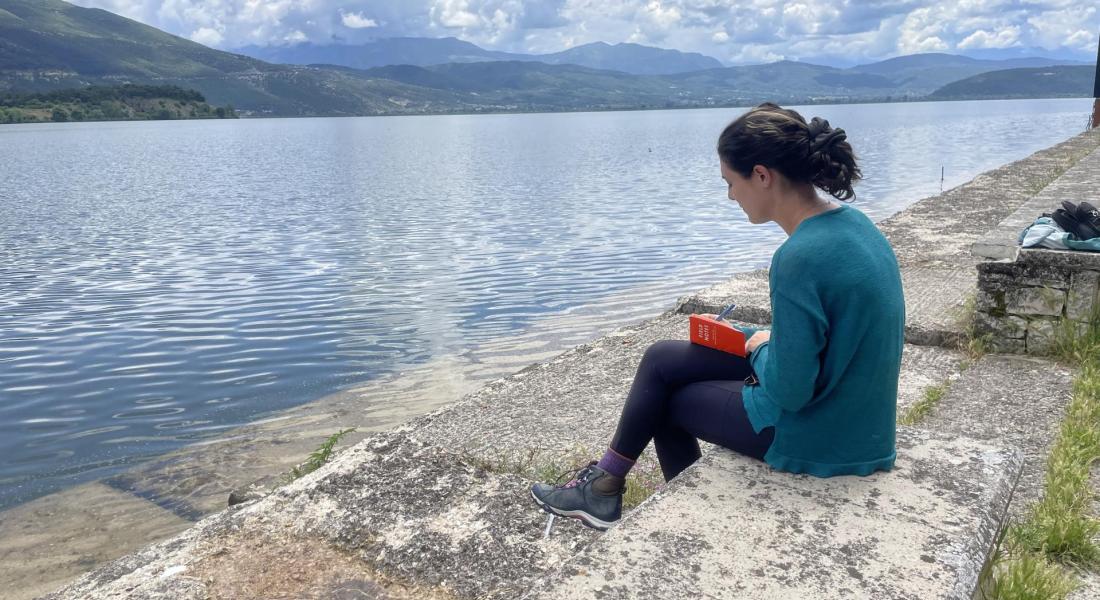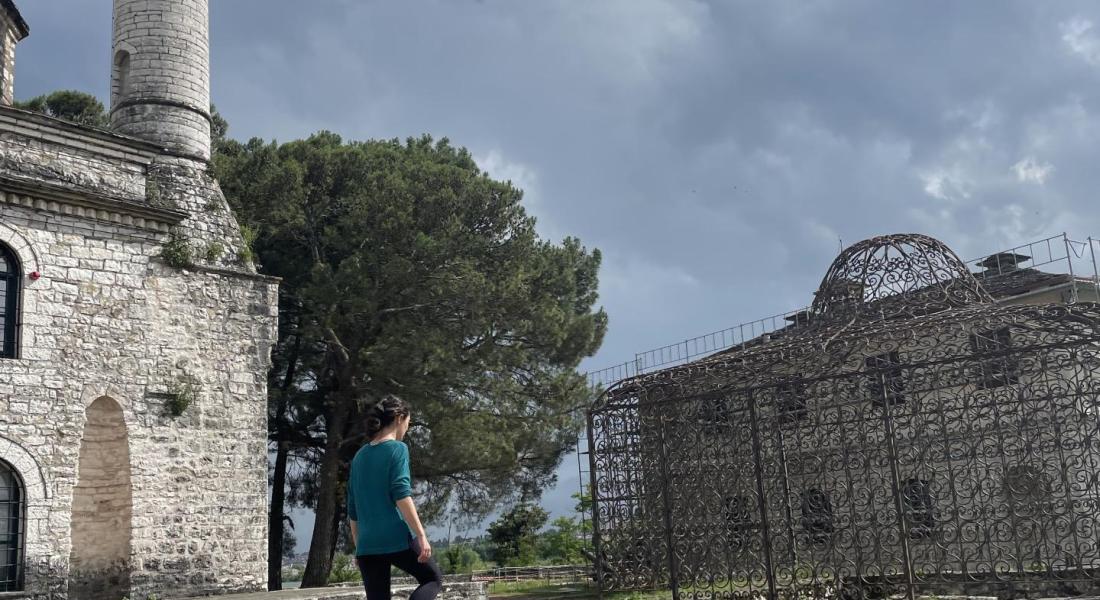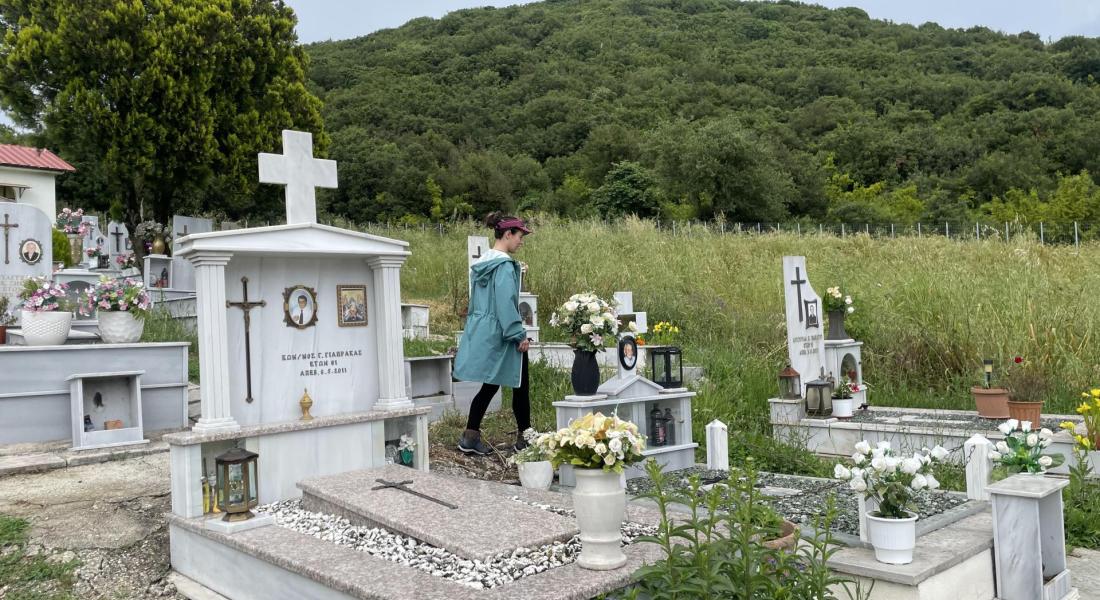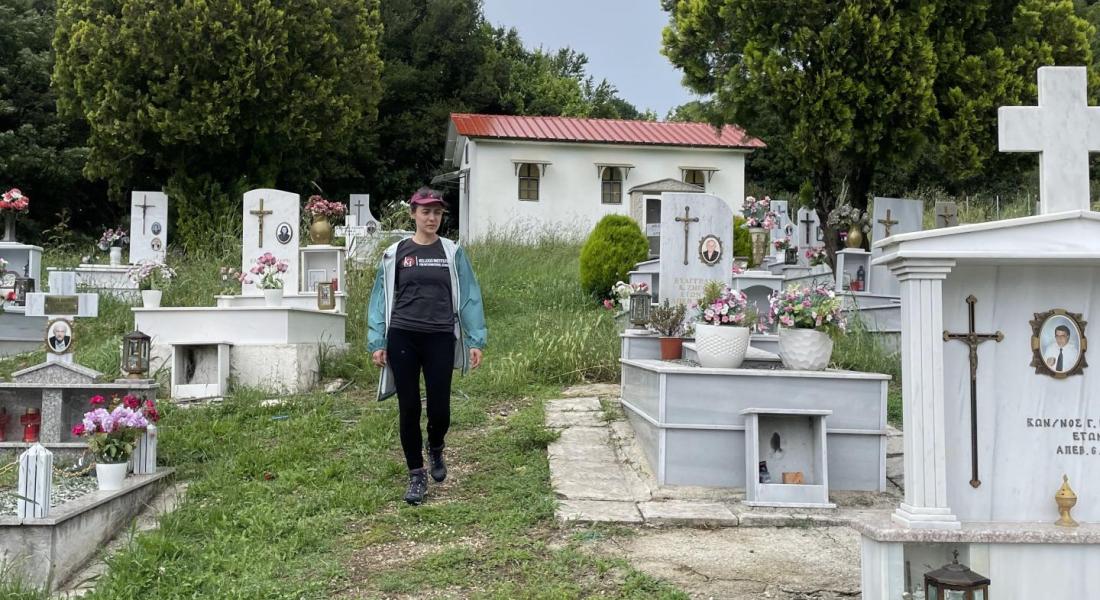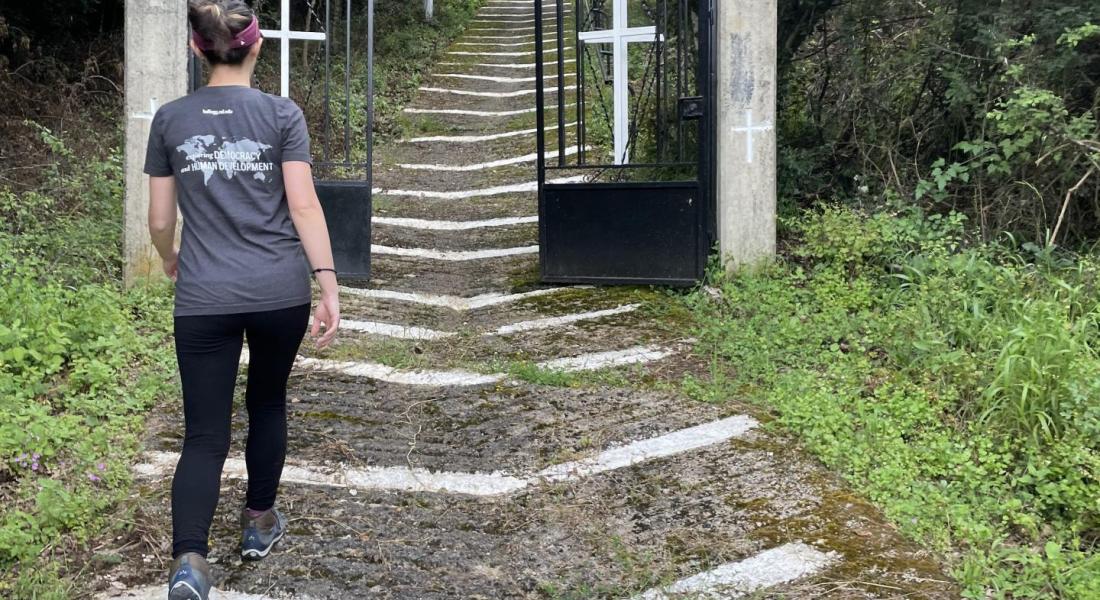In May 2023, Kellogg Doctoral Affiliate Isabel Mary Shiraef (political science) traveled to Greece on a Kellogg Institute Graduate Research Grant to conduct research for her project “The Authoritarian Legacy of Multiethnic Regime Engineering in Albania: a Preparation Trip to Add a Control Group in Greece." Upon her return, she sent the following summary of her work.
For my dissertation, I examine a largely unstudied communist policy and phenomenon in southern Albania whereby the communist leader, Enver Hoxha (pronounced hodja), both formally recognized the reek minority in some parts of today’s southern Albania and repressed them in others when the communist regime came to power in 1945.
Contrary to the notion that authoritarian governments uniformly repress diversity, Hoxha’s formal recognitions for Greeks meant that the communist party officials allowed Greek language schools to stay open, authorized cultural celebrations of Greekness to take place, and for Greeks to have government representatives, access to state services in Greek, as well as minority status-based military honors. The multiethnic approach imitated Stalin’s policies toward ethnic minorities, called korenitzatsiya in Russian (meaning indigenization), which were intended to transform local populations to adhere to the ideals of communism in their own language.
Hoxha’s systematic repression of Greeks meant the opposite: if a Greek family lived outside of the state-determined boundary for the minority, they were no longer allowed to attend Greek language schools, celebrate Greek holidays, access state services in Greek, or even speak Greek in public for fear of their lives. It should be noted that neither the recognized or repressed Greeks were permitted to openly celebrate traditional Orthodox holidays — especially after 1976 when religion was banned, and Hoxha declared that Albania was the first atheist country in the world. Indeed, every minority member living through Albania’s communist period experienced repression in some form — and everyone for that matter. But Greeks and other minority members who were born outside the villages selected for formal minority recognitions experienced far greater repression of their ethnolinguistic identity for the duration of the regime period—between 1945 to 1990—than those of the official minority zone.
If Hoxha recognized Greeks in some parts of Albania, why did he repress them in others? There are competing narratives about this question which I address in more detail in my dissertation with original data and party memos. But for purposes of this field report, the simplest answer is that Hoxha needed to contain the Greek minority to be a minority; doing so validated the emerging Albanian nationality as one that could stand its own ground (literally and conceptually) next to the world-renowned Greek nationality. Hoxha genuinely admired Greekness for its ancient roots and grew up encountering the Greek language in his birthplace of Gjirokastër through its substantial minority of Greek speakers. Showing Albania’s comparable greatness required maintaining a semblance of Greekness in the country — especially in a contiguous zone bordering Greece — but strongholds of Greek-speaking villages outside of this area needed to “become Albanian,” and, indeed, were forced to do so.
I call this two-pronged approach to shaping a nation’s modes of identity transmission, multiethnic identity engineering. Identity engineering is the strategic manipulation of ethnic groups by national elites in service to their political preferences. Multiethnic identity engineering is when national elites do this and recognize more than one ethnic group within the state apparatus, creating conditions of both recognition and repression — as occurred in Albania.
Identity engineering is all about power. Like good engineers, or social scientists for that matter, multiethnic identity engineers designed their power-building environment in such a way that the intended goal and challenges they faced determined the methods they used rather than the other way around. Sometimes this meant recognizing an ethnic group, and other times, repressing them. For all must be reformed regardless of age, gender, religious background, or ethnicity.
Most of the literature on Stalin’s treatment of minorities focuses on either his recognition or repression methods, but not both — as I do in the Albanian case. But surely, these very different experiences under communism had different consequences for the families that lived through them. We know already from Pop-Eleches and Tucker’s intensive cross-national study on the question, Communism’s Shadow, that people who lived through communism tend to carry political views distinctively more left than those who didn’t. Yet, we know much less about the variation that existed within those experiences of communism, in particular, for those with identities that were recognized versus repressed in the communist-era identity engineering programs.
Do Greek families that were repressed for their Greekness during Albanian communism shape identities distinctive from those that were formally recognized? What consequences did their respective experiences have for the generation that followed?
After establishing historical evidence of the policy in southern Albania, I set out to investigate what this policy meant for the families who experienced it and its long-term effects, if any, for the generations that followed.
Sampling Frame & Measurement
For identifying families whose backgrounds were Greek, I am using Albania’s first civil registry, which documented the language in which people had literacy in the period prior to communism (between 1930 and 1943). I restrict this further to families from villages with a majority of people literate in Greek to reduce capturing the experience of being in a Greek minority within one’s own village. Furthermore, I referenced but intentionally do not rely on statistics gathered by the Greek state during this period to reduce bias. It should further be noted that I select Greek-speaking villages within walking distance to Albanian-speaking villages since exposure to linguistic diversity was the norm rather than an exception in this period.
To measure the effects of identity engineering on families during communism, I primarily use new first names as opposed to ones from grandparents, local customs, or the Orthodox tradition. First names offer a strong signal of how family conventions responded to their newly engineered social environment since family heads had some choice in the matter, whereas they had less of a say about religious expression, language schooling, last name decisions, or political identifications once communism was in effect.
To see whether people’s identities shifted after communism fell in 1990, I supplement first name use with the linguistic script those same families placed on their ancestors’ graves, which is distinguishable between Albanian (e.g., GJERG) and Greek (e.g., ΓΕΩΡΓΙΟΣ). Use of the Greek script on a grave outside of the state-authorized minority zone was not allowed during communism, but since then, freedom of speech is better protected; people can and often do replace their family member’s past gravestones with new ones, “correcting the record,” so to speak.
Dissertation Method & Hypotheses
I compare the proportions of both of these identity markers over time at the village level, before and after identity engineering was introduced in 1945 and geographically between the two differently treated groups in southern Albania. I expect to identify a significant shift in identity transmission during communism, and continued variation after 1990, albeit less so since both groups then had the opportunity to go to Greece, study in Greece and assimilate in their own terms rather than those of the communist regime.
Regarding political attitudes after communism, there’s an argument to be made in both directions: on the one hand, ethnically based repression could lead to entrenched anger, identity conflicts, and anti-communist ideals erupting in local politics after the regime fell as a result; but on the other, the experience of intense repression could lead to continued fear, an amicable approach to politics, and muted political views seeking alignment with the status quo — which tends to be left in post-communist regimes and indeed, is left in Albania).
Summer Research, Purpose and Goals
My summer research, supported by the Kellogg Institute for International Studies, piloted an extension of my dissertation’s data collection into northern Greece. Gathering a sample of data from Greece will allow me to make use of the fact that in 1945, Albania’s border was closed with Greece, forging a second, significant division amongst the Greek-speaking families in this region. I proposed to advance my research with visits to village cemeteries in Greece that had proximity to Albanian-speaking populations prior to Albania’s communist period, laying the groundwork for targeting a more intensive data-gathering venture supported by a Fulbright-Hays fellowship this fall.
Different from the multiethnic identity engineering that Greek speakers in southern Albania experienced after 1945, those near Albanian-speaking minority areas in Greece experienced the Greek state’s assimilationist program — which sought to homogenize modern Greece’s linguistic diversity. Effectively, they experienced the Western approach to national identity or the “melting pot” model as it is called in the United States context — allowing an important comparison point for my study.
Thus, my main goal in expanding into Greece is to find a linguistically comparable baseline population to compare with those in my main sample in Albania. This will allow me to use the border closure of 1945 as a rupture point between the three groups, i.e., (1) the recognized minority members, (2) the repressed minority members, and (3) those who were neither recognized or repressed as a minority, instead being treated as a Greek majority group, despite similar ethnolinguistic origins, previous exposures to each other, and continued, comparable proximity to Albanian-speaking populations.
Thus, starting in May, I targeted areas known to have contained Albanian speakers in Greece prior to 1945 in hopes of locating a baseline sample of villages comparable to those I have been capturing cemetery data on in southern Albania. I also established contact with several local organizations with which I will cooperate more during my Fulbright.
Summer Fieldwork
To gain a sense of the local dynamics of Albanian-ness in Greece, I documented a sample of cemetery data, comprehensively from the island of Agistri in the region of Attica and several villages north of Greece with comparable proximity from the Albania-Greece border as those used in my sample from southern Albania (including Kouklioi, Parakalamos, Geroplatanos, and Dodoni). I also covered the municipal cemetery of Ioannina by taking photos of each grave.
I photographed the depiction and text of each public monument I encountered — launching a database of monuments, memorials, and meaning constructed before, during, and after Albania’s communist period (1945 to 1990) in Greece similar to the one I have finished in southern Albania. With data transcription assistance, I transcribed each grave into an individual row of data, with which I will produce the baseline statistics for my project’s control group. I recorded interviews of locals and took field notes each day of anything I learned about “Albanian-ness in Greece,” not caught on tape or in a photo.
I also visited significant sites representing Albanian-ness in Greece, one of which is the home where the Albanian-speaking, Ottoman-era leader of the region, Ali Pasha, was assassinated by the Ottomans in 1822 on Ioannina Island and another of which is his tomb in Ioannina’s town. Another is a beach in the Peloponnese called Arvanitias.
Findings, Albanian-ness in Greece
Greek national narrative about Albania: Ali Pasha’s former vacation home that staged his dramatic execution and beheading, is now a local folklore and Greek revolutionary museum — expertly and persuasively integrating local narratives with the national one about the intensive suffering of Greeks intensive suffering of Greeks at the hands of Ottoman rulers. Pasha’s tomb, looming in front of the towering Fethiye Mosque, was taken down in 1940 but has been reconstructed in Ioannina town with an ornate iron cage around his and his Greek wife’s graves.
Ali Pasha’s impressive tomb and his former home both provide stark memorials to the significant extent to which local populations in Greece were exposed to “Albanian-ness” prior to 1945. They also illustrate how the Greek state and its local elites have nationalized the narrative in their own terms since Pasha’s time. For instance, Ali Pasha’s former home now stages a dramatic reenactment scene of one of his most brutal and politicized acts in 1800 — when he ordered a Greek socialite, Kyra Frosini (“Lady Frosini”), to be drowned in the Lake of Ioannina for adultery — along with 17 other women. The room has no windows to give the impression of being the dead of night, as legend has it for the mass drowning, and a local folk song about the event plays eerily over the scene.
The popular Greek narrative about Frosini’s killing — depicted in poems, folk songs, a film, a novel, and even an opera — is that she was killed after Ali Pasha learned of her dealings in the resistance movement against the Ottomans. Very different from the communist Albanian narrative, which celebrated the tales of Orthodox Greeks and Muslim Albanians shaking off the Ottoman tyranny by fighting together, the Greek narrative of Frosini’s story slurs Albanians together with the Ottoman Turks, depicting their acts of brutality and Greeks as the victims.
Arvanitias beach in Nafplion, a city in the Peloponnese and former capital city of Greece, has a similarly gruesome local legend about the brutality of Albanians — which I was unable to verify or even straighten out to retell among the many varieties of the tale. In reality, the beach may carry the name simply because Arvanitika speakers have long lived there. But the local legend, tied to the national one, prevails.
Albanian names in Greece: The first names used by villagers among Arvanitika-speaking populations in Greece were nearly all Orthodox names, using Greek script, and indistinguishable from the Greek-speaking families in local cemeteries. By preliminary comparison, they also had noticeably lower diversity among the names used than the groups I surveyed in Albania — perhaps indicating that people largely followed the Orthodox practice of naming children after grandparents without a noticeable shift after 1945, as I have begun to identify in Albania before and especially during Albania’s communist period. This was in line with my expectations since they did not experience the tradition-rupturing communist takeover the other two groups in my study had. Closer analysis and additional cemetery and ethnographic data are needed, however, before drawing conclusions.
Albanian language in Greece: To my surprise, I learned that several villages and islands contain locals who still regularly speak their old form of Albanian, called Arvanitika, with each other in the public squares. Despite decades of enduring the Greek state’s anti-Albanian narrative, and evidence of their assimilation to Greekness shown in local cemeteries, the Albanian-speaking minority in Greece maintained their local dialect, sharing the etymological root with today’s Albanian. These locals, largely women, are also fluent in Greek, as is likely the case for all Arvanitika speakers, given the extent of time they have experienced the assimilation model of modern Greece. They speak Arvanitika socially with each other.
Their family member’s graves are not distinctive in Greece because they use Greek Orthodox names and Greek script on their graves. They often married non-Arvanitika speakers. I did not encounter anyone younger than 85 who still spoke Arvanitika, indicating the language is not being transmitted to younger generations. However, further research should be done among those born into Arvanitika-speaking families to understand the extent of the assimilation.
Was Arvanitika revived by the massive wave of Albanian speakers who left Albania and migrated to Greece after 1990? Presumably, but after Hoxha’s standardization of Albanian and 45 years of intensely enforced separation — during which no formal recognition for Greece’s Albanian-speaking minority occurred — differences in the spoken language are audibly apparent. Still, if the Albanian-speaking population in Greece acted similarly to the Greeks I have interviewed who were forcibly assimilated in Albania, they maintained the language in their homes and within their local community during Greece’s intensive nationalizing period. I will spend more time with this population in my upcoming research in Greece to find out.
Less surprisingly, I also discovered that Albanian speakers in Greece are shocked and often delighted to meet and welcome an Albanian speaker from a foreign community — even someone with broken Albanian, such as myself. Ironically, some of the best home-cooked meals I have eaten in Greece stemmed from having spoken Albanian.
Still, compared to Italy’s case of old Albanian speakers (called Arbëresh), Greece’s Albanian speakers are far less visible, and the language is endangered of dying out altogether. Other scholars explain that Italy’s Arbëresh is more likely to survive than Greece’s Arvanitika because Italian nationalism is less threatened by ethnic diversity than Greece’s nationalism — which has long persecuted minority groups.
Takeaway
The state-level memorials to Albanian-ness in Greece, combined with those from the local level population, gave me confidence in my project’s research design, which rests on an interconnected and deeply politicized history between “Greekness” and “Albanian-ness.” The monuments I documented reassured me that these divergent national narratives was physically and vividly encountered amongst the three groups of my study. They affirmed that starkly different approaches between communist Albania and Greece toward ethnic minorities between 1945 and 1990. My project’s historical claim— that Albania engineered Greekness into their national narrative whereas Greece disregarded and demonized Albanian-ness for theirs — rings true, even still today.
Next Steps
To identify a comparable sample with my groups based in Albania, I will continue expanding my sample of grave data to include sixteen more villages using a Fulbright-Hays fellowship. Then, similar to the process piloted above, I will transcribe the data with research assistance. I will also attempt to access Greece’s household-level registry as I did in Albania. This can help me address bias or missingness produced in grave data by showing a more complete snapshot of the local population’s naming decisions over time.
Acknowledgments
My dissertation research would not be possible without my research assistants, Kristian Peçi, Igri Mama, Bujari Ago, Sara Ago, Urania Gjoci, Ilia Gjoci, and one who wishes to remain anonymous.
I am also grateful to my dissertation supervisor, Susanne Wengle; my committee members, Victoria Hui, Jaimie Bleck, David Laitin, and Scott Mainwaring; and my in-country advisors, Konstantinos Giakoumis (Logos University), Linda Mëniku (American Councils), and George Siakas (University of Macedonia).
For supremely generous discussant comments, I am grateful to Vicky Fouka, Nicholas Hass, and Panzano Guido.
The Kellogg Institute for International Studies generously funded the work described above.
Selected sources
Nataša Gregorič Bon. 2008. Storytelling as a spatial practice in Dhërmi/Drimades of Southern Albania, Anthropological Notebooks, 14 (2).
Sindorela Doli Kryeziu. 2018. The Path of Standard Albanian Language Formation, European Journal of Social Science Education and Research, 5(2).
Elsa Pollozhani. 2019. Language Shift among the Arbereshe of Italy, European Journal of Language and Literature Studies, 5(1).
Gilles de Rapper. 2023. Photographic Archives and the Anthropology of Communism in Albania, Comparative Southeast European Studies, 70(4).
༺═──────────────═༻
For more project updates, follow Mary on Medium or support her work directly on her Buy Me a Coffee page.






